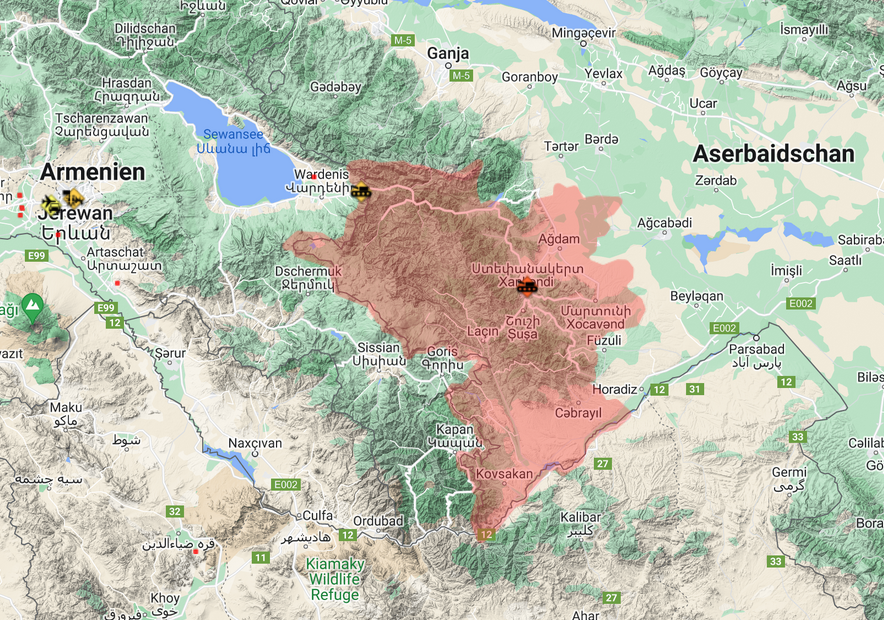Focus Event: Armed Conflict in Nagorno-Karabakh
- The Azerbaijani military offensive on the disputed region of Nagorno-Karabakh ended in a ceasefire; separatists have started to give up their weapons.
- The humanitarian situation in the affected areas is still severe; in surrounded Stepanakert people are preparing to leave for Armenia.
- Yerevan sees daily protests against the government’s passivity.
- By Saturday (30 September), more than 100,000 people had fled Nagorno-Karabakh.
As of 2 October, 10 am (local time, GMT+4)
Overview. The large-scale “anti-terrorist operation of local character to restore constitutional order” of the Azerbaijani armed forces against Nagorno-Karabakh from Tuesday to Wednesday (19/20 September) was declared over by the Azerbaijani president. Casualties on the side of the Nagorno-Karabakh Armenians amount to hundreds of dead and injured. First talks on a re-integration of the region into Azerbaijan took place on Thursday (21.09.) and were described as “constructive”. On Friday (22 September), the separatist leadership began to withdraw its troops and hand over its weapons. On Sunday (24 September) it was announced that most of the 120,000 inhabitants wanted to move to Armenia. Germany’s Federal Foreign Office continues to warn against travel to the Nagorno-Karabakh region as well as to the entire Azerbaijani border area with Armenia or to various areas of Armenia’s border area with Azerbaijan. The FCDO advises against all travel to Nagorno-Karabakh as well as to the surrounding regions; the advice on Armenia remains unchanged.
Einschränkungen vor Ort. Direct fighting ended after one day. In the de facto capital Stepanakert, bullets also hit residential buildings and affected civilian infrastructure. The extent of the damage in other regions was not known at first, as communication between the individual localities was still interrupted for days. Already on the first day, a total of 10,000 people were evacuated from villages in the regions of Askeran, Martakert, Martuni and Shushi. Several thousand people found refuge at Stepanakert airport (which never became operational), where the base of Russia’s so-called “peacekeeping forces” is located. Azerbaijani troops surrounded Stepanakert, where residents and refugees continued to hold out in their basements or in the open until Sunday (24 September). After months of blockade, there was no electricity, gas or fuel, nor food, internet or telephone connections. At the weekend, the first aid supplies were sent to Stepanakert, and the Azerbaijani authorities restored the power supply on Monday night (25 September). Already on Saturday (23 September), Armenia had asked the United Nations to send a mission to Nagorno-Karabakh to ensure the safety of the inhabitants. At the same time, a major exodus began, amid which a fuel tank exploded in Stepanakert on Monday evening (25 September). Reports currently speak of 170 dead and several hundred injured. Those willing to leave who lack transport can register for bus transfer at the Armenia Hotel in Stepanakert since Tuesday (26 September).
Impact in Armenia and Azerbaijan. It is possible to leave Armenia without restrictions via Yerevan airport and Azerbaijan via Baku. In Azerbaijani areas bordering Nagorno-Karabakh, only brief sporadic fighting was recorded. Access to social media channels was restricted, but otherwise no impact of the military offensive was felt in Baku and other regions of Azerbaijan. In neighbouring Armenia, things also remained quiet, including in the border area with Azerbaijan, as Armenia’s regular troops were not involved in the confrontation. In the centre of Yerevan, however, there are daily demonstrations and roadblocks; on Friday, main roads between Sevan, Gavar and Martuni on the southern shore of Lake Sevan were also blocked. In the south of the country, which is currently avoided by most commercial tour operators due to various travel warnings, an increased concentration of security forces can be expected in the coming days. Restrictions due to refugee flows are possible since Monday (25 September), because according to the leadership of Nagorno-Karabakh Armenians, most of the 120,000 inhabitants want to come to Armenia. In the border town of Kornidzor (Syunik), more than 100,000 refugees have arrived until Saturday (30 September).
Possible further developments. The leadership of Nagorno-Karabakh has announced that it will dissolve the breakaway republic of Artsakh on 1 January 2024. However, the situation in the South Caucasus remains tense. At a meeting, the presidents of Turkey and Azerbaijan hinted at wanting to impose a corridor through “West Zangezur”, the Armenian province of Syunik. In response, France sent a military attaché to Armenia one day later with the mission to open a consulate in Syunik. At the same time, the Turkish president backed down and declared that negotiations were also being held with Iran on a possible transport corridor (through Iranian territory).

